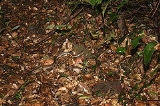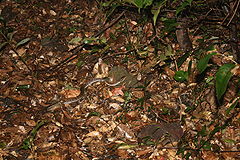
Gloydius ussuriensis
Encyclopedia
- Common names: Ussuri mamushi.
Gloydius ussuriensis is a venomous
Venomous snake
"Poisonous snake" redirects here. For true poisonous snakes, see Rhabdophis.Venomous snakes are snakes which have venom glands and specialized teeth for the injection of venom...
pitviper
Crotalinae
The Crotalinae, commonly known as "pit vipers" or crotaline snakes, are a subfamily of venomous vipers found in Asia and the Americas. They are distinguished by the presence of a heat-sensing pit organ located between the eye and the nostril on either side of the head...
species
Species
In biology, a species is one of the basic units of biological classification and a taxonomic rank. A species is often defined as a group of organisms capable of interbreeding and producing fertile offspring. While in many cases this definition is adequate, more precise or differing measures are...
found in far east Russia, northeastern China
China
Chinese civilization may refer to:* China for more general discussion of the country.* Chinese culture* Greater China, the transnational community of ethnic Chinese.* History of China* Sinosphere, the area historically affected by Chinese culture...
and the Korean Peninsula
Korean Peninsula
The Korean Peninsula is a peninsula in East Asia. It extends southwards for about 684 miles from continental Asia into the Pacific Ocean and is surrounded by the Sea of Japan to the south, and the Yellow Sea to the west, the Korea Strait connecting the first two bodies of water.Until the end of...
. No subspecies
Subspecies
Subspecies in biological classification, is either a taxonomic rank subordinate to species, ora taxonomic unit in that rank . A subspecies cannot be recognized in isolation: a species will either be recognized as having no subspecies at all or two or more, never just one...
are currently recognized.
Description

The scalation usually includes 21 rows of dorsal scales
Dorsal scales
In snakes, the dorsal scales are the longitudinal series of plates that encircle the body, but do not include the ventral scales.When counting dorsal scales, numbers are often given for three points along the body, for example 19:21:17...
at midbody, all of which are keeled
Keeled scales
Keeled scales refer to reptile scales that, rather than being smooth, have a ridge down the center that may or may not extend to the tip of the scale, making them rough to the touch...
(although the keels on the first scale rows are faint), 146-157 ventral scales
Ventral scales
In snakes, the ventral scales are the enlarged and transversely elongated scales that extend down the underside of the body from the neck to the anal scale. When counting them, the first is the anteriormost ventral scale that contacts the paraventral row of dorsal scales on either side...
and 39-54 subcaudal scales
Subcaudal scales
In snakes, the subcaudal scales are the enlarged plates on the underside of the tail. These scales may be either single or divided and are preceded by the anal scale....
. There are 7 supralabial scales
Supralabial scales
In reptiles, the supralabial scales, also called upper-labials, are those scales that border the mouth opening along the upper jaw. They do not include the median scale . The term labial originates from Labium , which refers to any lip-like structure...
, with the second being the smallest and the fourth usually the largest.
The color pattern consists of a light brownish gray to blackish ground color overlaid with a series of 24-33 relatively large and usually elliptical dorsolateral blotches. These blotches, which may oppose or alternate on either side of the middorsal line, are usually closed and have a pale interior with a dark smudge in the center that makes them look like a row of bull's-eyes on either side of the body. The bloches are separated laterally by one scale row, extend down to the first scale row, and may merge with blotches across the middorsal line. A dark postocular stripe is present that is bordered above by a narrow yellow or white line.
Geographic range
Found in far east Russia (Primorskiy KrayPrimorsky Krai
Primorsky Krai , informally known as Primorye , is a federal subject of Russia . Primorsky means "maritime" in Russian, hence the region is sometimes referred to as Maritime Province or Maritime Territory. Its administrative center is in the city of Vladivostok...
), northeastern China
China
Chinese civilization may refer to:* China for more general discussion of the country.* Chinese culture* Greater China, the transnational community of ethnic Chinese.* History of China* Sinosphere, the area historically affected by Chinese culture...
, North Korea
North Korea
The Democratic People’s Republic of Korea , , is a country in East Asia, occupying the northern half of the Korean Peninsula. Its capital and largest city is Pyongyang. The Korean Demilitarized Zone serves as the buffer zone between North Korea and South Korea...
and South Korea
South Korea
The Republic of Korea , , is a sovereign state in East Asia, located on the southern portion of the Korean Peninsula. It is neighbored by the People's Republic of China to the west, Japan to the east, North Korea to the north, and the East China Sea and Republic of China to the south...
, as well as on Quelpart Island
Jeju-do
Jeju-do is the only special autonomous province of South Korea, situated on and coterminous with the country's largest island. Jeju-do lies in the Korea Strait, southwest of Jeollanam-do Province, of which it was a part before it became a separate province in 1946...
. Chernov proposed that the type locality be restricted to "Suchan River (in Primorskiy Kray)."
Taxonomy
This species has long been confused with G. saxatilis in KoreaKorea
Korea ) is an East Asian geographic region that is currently divided into two separate sovereign states — North Korea and South Korea. Located on the Korean Peninsula, Korea is bordered by the People's Republic of China to the northwest, Russia to the northeast, and is separated from Japan to the...
and G. blomhoffii brevicaudus
Gloydius blomhoffii brevicaudus
Gloydius blomhoffii brevicaudus is a venomous pitviper subspecies found in China and the Korean Peninsula.-Description:Adults are relatively stout with a broad head and a short tail. The largest male examined by Gloyd and Conant was 71 cm in total length of which the tail was 9 cm, the...
in eastern parts of Liaoning
Liaoning
' is a province of the People's Republic of China, located in the northeast of the country. Its one-character abbreviation is "辽" , a name taken from the Liao River that flows through the province. "Níng" means "peace"...
in China
China
Chinese civilization may refer to:* China for more general discussion of the country.* Chinese culture* Greater China, the transnational community of ethnic Chinese.* History of China* Sinosphere, the area historically affected by Chinese culture...
, where it is sympatric
Sympatry
In biology, two species or populations are considered sympatric when they exist in the same geographic area and thus regularly encounter one another. An initially-interbreeding population that splits into two or more distinct species sharing a common range exemplifies sympatric speciation...
with these forms. Its variable color pattern has not helped matters either.

